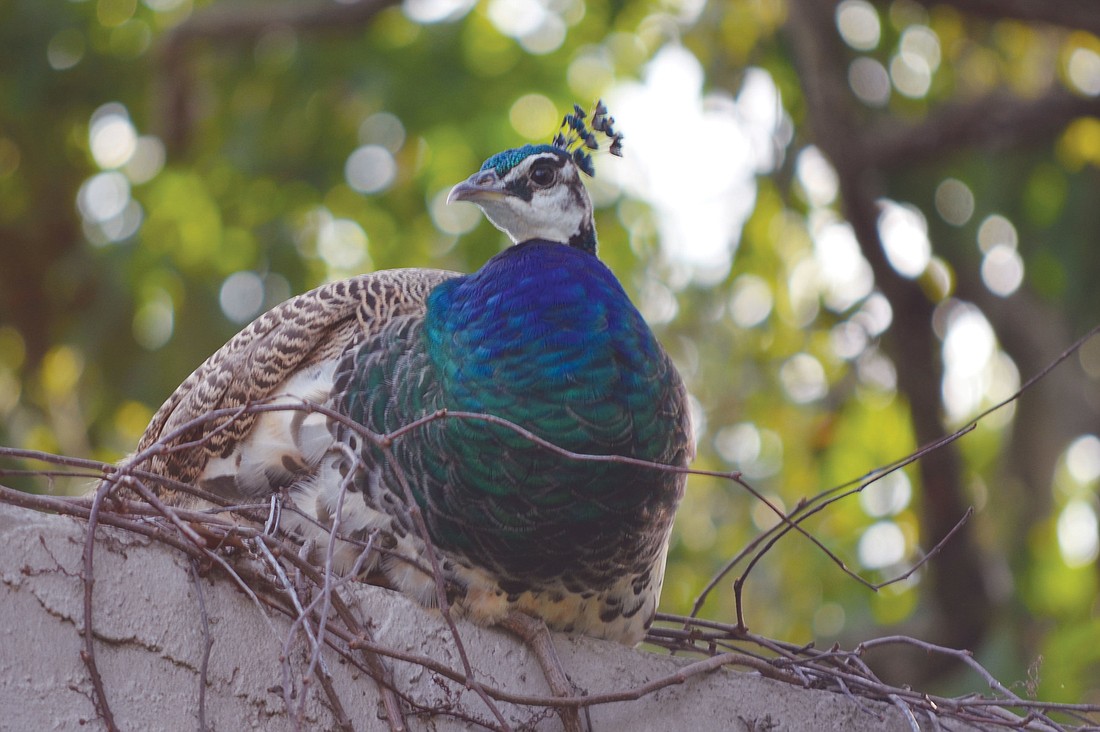- November 25, 2024
-
-
Loading

Loading

Some Indian Beach residents have noticed a few new colorful neighbors in the past year.
A family of peafowl, including two adult peahens, a peacock and two peachicks, have made themselves at home in a two-block stretch of the west-of-the-trail neighborhood.
“They tour around from 40th to 42nd avenues near Bayshore Avenue,” says neighbor Suzy Hagglund, who lives on 41st Street.
“We don’t really know how they appeared,” Hagglund said. “They just appeared last year.”
Neighbors watched the flock that began with the male and two female companions grow to seven with the birth of four peachicks. Two of the chicks, however, did not survive. Peafowl breeding season takes place from April to August.
“It was fun to watch them grow up,” Hagglund said about the two other chicks.
Peafowl are large domestic birds related to pheasants. Many of the neighbors have exchanged stories about them, and some neighbors even feed them. At night, the family roosts in a large pine tree.
“I would see them almost every morning around sunrise,” Hagglund said. She most recently saw the peafowl last week.
Although the peafowls eat garden plants, can scratch cars, roost on structures, leave messy droppings and have loud, screeching calls, residents in the neighborhood say the small flock in Indian Beach is just interesting to watch and isn’t causing too many problems — for now.
“The females are green,” Hagglund said. “The male is Mediterranean blue. He’s beautiful and starting to get his full plumage and display it.”
Peafowl are not protected by the Florida Fish and Wildlife Commission because they are not considered wildlife. And, they are not native to Florida.
“They are domestic fowl, like chickens,” said Gary Morse, spokesman for the Florida Fish and Wildlife Commission (FWC). “People either love them for their beautiful feathers or hate them for the ruckus and mess they make.”
On the north end of Longboat Key, Longbeach Village’s flock of peafowl has caused its share of trouble throughout the years, including scratching cars, jaywalking and screeching. In past years, the Longbeach Village Association hired trappers in an effort to reduce the flock to 12.
The peafowl in the Village even became the subject of a Christian Science Monitor article in December 2009 headlined, “Peacocks become a colorful problem in Florida.”
In the neighborhood of Indian Beach, the peafowl have some fans, even though the fowl have shown a preference for eating residents’ plants.
Patricia Moore, who lives on 41st Street, a few blocks from Hagglund, said she frequently sees the peafowl moseying around her yard.
“They love my yard,” Moore said.
The peafowl used to nip the buds of her plants, but they’ve stopped.
“That could be because they ate all of them and I didn’t get to replanting them,” Moore said.
But Moore enjoys watching the beautiful fowl.
“My only concern is how quickly the flock will grow,” Moore said. “We are all aware of the situation in the Village (on Longboat).”
Hagglund said the peafowl have also eaten some garden plants from other yards, and some residents who have fed the peafowl now wished they hadn’t. Some have put netting over their plants to keep the peafowl from eating them.
Hagglund does not feed them or encourage them to come into her yard.
Morse said it is possible that someone released the peafowl in the neighborhood.
Vald Svekis, the president of the Indian Beach Neighborhood Association who lives a few blocks north of the peafowl in the neighborhood, said he has yet to spot them. But, Svekis said he thinks the topic could come up at an upcoming neighborhood association meeting if enough people are talking about it.
Svekis photographed a bald eagle pair recently near the seawall at Sapphire Park.
“Maybe we can have Realtors advertise: Move to our neighborhood and see bald eagles and peacocks,” Svekis said.
No matter how beautiful the fowl may be, however, the species of domestic fowl is not native to Florida, Morse said.
“Interestingly enough, peacocks were brought to the United States not because of the fact are pretty, but for food,” Morse said.
If an owner does not claim the peafowl, residents can have them removed from their property, Morse said. A licensed wildlife trapper can remove the peafowl.
Some of the peafowl removed from Longboat Key were relocated to a farm.